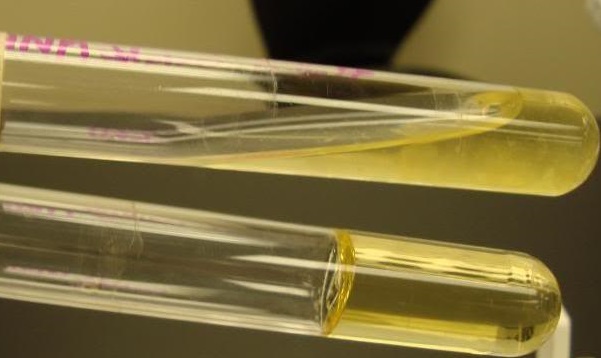| 培养基名称 | 营养明胶 |
|---|---|
| 英文名称: | Nutrient Gelatin |
| 培养基类型: | 鉴别培养基 |
| 级别: | for microbiology |
| 品牌: | ELITE-MEDIA |
| 产品目录号: | M739-01、M739-02 |
| 产品规格: | 250g 、500g |
| 产品外观: | 土黄色粗糙粉末。 |
| 颜色与澄清度: | 浅黄色透明或略不透明凝胶。 |
| 保存条件: | 密封,至于30度以下,干燥处保存。 |
| 注意事项: | 避免摄入、呼入、皮肤接触。 |
| 相关产品: | -- |
产品描述:
营养明胶培养基(Nutrient Gelatin)是基于微生物产明胶酶能力的鉴别培养基,通过明胶水解试验鉴别肠杆菌科微生物。
营养明胶培养基工作原理
明胶是第一个作为培养基凝固剂使用的物质,但是缺点是明胶在32°C开始融化,因此只能在20°C左右培养,低于绝大多数微生物最适生长温度。后来琼脂取代了明胶作为培养基的凝固剂。明胶水解试验用于检测微生物产一种胞外酶——明胶酶(蛋白水解酶)能力。明胶的液化表明明胶酶的存在。这个过程分两个阶段,第一个反应是明胶降解成多肽。然后多肽被进一步转化成氨基酸。细菌细胞可以吸收氨基酸,用于新陈代谢过程。明胶被水解后,失去凝胶特性,变成液体状。
用途:
明胶水解试验在鉴别和区分和鉴别芽孢杆菌、芽胞梭菌、变形杆菌、假单胞菌和沙雷氏菌时十分有用。明胶水解试验能够区别明胶酶阳性、致病性金葡菌与明胶 酶阴性、非致病性表皮葡萄球菌。革兰氏阳性、产芽孢、杆状、好氧菌或厌氧菌如炭疽芽孢杆菌、蜡状芽孢杆菌、枯草芽孢杆菌、产气芽孢梭菌和破伤风杆菌也是明胶水解阳性。该试验也可以用于区分产明胶酶的沙雷氏菌、变形杆菌与其它肠杆菌。配方与配制方法
| 培养基成分: | 含量:g/L |
|---|---|
| 蛋白胨 | 5.0 |
| 牛肉提取物 | 3.0 |
| 明胶 | 120.0 |
| pH | 6.8 ± 0.2 |
配制方法:
1. 称取128.0g本品,加1L去离子水,浸泡15min。
2. 加热50°C,不断搅动使其完全溶解。
3. 分装到试管中。
4. 121°C高温蒸汽灭菌15min。
实验方法
验证明胶产生能力的方法有几种,标准的且最常用的方法是营养明胶穿刺法。1. Inoculate a heavy inoculum of test bacteria (18- to 24-hour-old) by stabbing 4-5 times (half inch) on the tube containing nutrient gelatin medium.
2. Incubate the inoculated tube along with an uninoculated medium at 35°C, or at the test bacterium’s optimal growth temperature, for up to 2 weeks.
3. Remove the tubes daily from the incubator and place in ice bath or refrigerator (4°C) for 15-30 minutes (until control is gelled) every day to check for gelatin liquefaction.(Gelatin normally liquefies at 28°C and above, so to confirm that liquefaction was due to gelatinase activity, the tubes are immersed in an ice bath or kept in refrigerator at 4°C).
4. Tilt the tubes to observe if gelatin has been hydrolyzed.
Test for gelatin liquefaction by incubating a Nutrient Gelatin stab or plate culture at 20-22 °C. Alternatively, incubate at a higher temperature (usually optimum for the organism under investigation) and then transfer the tube to a refrigerator or into cold water before observation. The latter method not only allows determinations to be carried out on organisms which grow slowly or not at all at 20-22°C but also usually avoids false positive results produced by the release of enzymes after the death of the organisms.
If the medium is incubated at a higher temperature it is necessary to employ uninoculated controls to allow for the hydrolytic effect of heat and other factors. Rates of liquefaction vary considerably, so that some organisms produce liquefaction within a few days whereas others require several weeks. For practical purposes, a maximum incubation period of 14 days is suggested.
Considerably longer incubation may be necessary, some strains of Enterobacter cloacae liquefied gelatin only after 3 months at 20-22°C5. Especially where prolonged incubation is necessary, it is important to ensure adequate closure of the containers in order to prevent dehydration of the medium. Besides its presence or absence, the shape and nature of the liquefied portion of the stab culture are often useful identifying characteristics.
Particularly with plate cultures, gelatin liquefaction may be detected sooner by the `Stone reaction’ ( Stone6 ): add a drop of saturated aqueous ammonium sulphate solution, or of fresh 20% aqueous sulpho-salicylic acid solution, to an individual colony growing on Nutrient Gelatin. A positive reaction (i.e. gelatin liquefaction) is indicated by the presence of a clear zone round the colony after 10 minutes contact with either reagent. This method is slightly less sensitive but several strains may be tested on one plate. The `Stone reaction’ is also employed with Staphylococcus Medium No.110 for the differentiation of staphylococci.
For the standard gelatin plate count on water ( American Public Health Association) dilute the original sample with sterile tap water and place 0.5 or 1ml of the dilutions in each dish of at least two duplicate sets of sterile Petri dishes. Cool the sterile prepared Nutrient Gelatin to approximately 42°C and aseptically add 10ml to each Petri dish. Mix the contents by tilting and rotation, allow to solidify as soon as possible after pouring and immediately place in an incubator at 19-21°C. Incubate for 48 ± 3 hours and count at least two plates made from the dilution giving between 30 and 300 colonies per plate.
结果与分析
ATCC标准菌株 生长 明胶酶活性
Bacillus subtilis ATCC9372 + +
Clostridium perfringens ATCC13124 + +
Escherichia coli ATCC25922 + -
Staphylococcus aureus ATCC25923 + +


